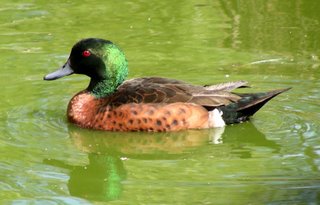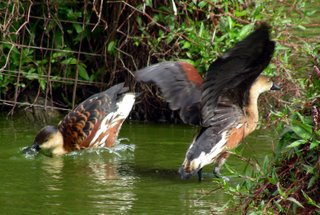Let’s see. We could line ‘em up in order of size. Ducks are small, swans are big and geese are somewhere in the middle.
Or by plumage. Ducks are colourful, swans are white—or black or black and white—and geese are somewhere in the middle.
 Hmmm. I thought I could see a pattern. But when I checked the most recent studies on the Anseriformes* (the group to which they all belong), the story wasn’t quite that simple. Ducks? Tick. Swans? Tick. Geese? Well, it seems that they’re what’s left over when the ducks and swans are taken out.
Hmmm. I thought I could see a pattern. But when I checked the most recent studies on the Anseriformes* (the group to which they all belong), the story wasn’t quite that simple. Ducks? Tick. Swans? Tick. Geese? Well, it seems that they’re what’s left over when the ducks and swans are taken out.There are true geese, which belong to genera Anser and Branta. No one has a problem with those. There are true swans—Cygnus and their close relative Coscoroba of South America. And there are a dozen or so genera of true ducks. But that still leaves a bunch of others floating about without a neat … er … pigeon hole to roost in.
 Among the orphans are the shelducks and sheldgeese. This group has long been recognised as an anomalous one, with features characteristic of both ducks and geese but fitting in with neither. Apart from the widespread Tadorna shelducks, the group includes Chloephaga sheldgeese from South America, African Alopochen 'geese' and others.
Among the orphans are the shelducks and sheldgeese. This group has long been recognised as an anomalous one, with features characteristic of both ducks and geese but fitting in with neither. Apart from the widespread Tadorna shelducks, the group includes Chloephaga sheldgeese from South America, African Alopochen 'geese' and others.One classification treats the group as belonging with true ducks. Another puts it with the geese and swans. A third leaves it out on its own ...
Whistling-ducks (Dendrocygnus) are another enigmatic group. Although they are colourful birds that look a lot like ducks and walk a bit like ducks they just aren't ducky enough. Nor are they geese. Nor, despite the scientific name, are they tree-dwelling swans. Whistling-ducks are more or less out on their own in a lineage that diverged early on from the rest of the Anseriformes.
 The magpie goose (Anseranas sempalmata) is another oddity. When Latham described it in 1798, he placed it in Anas, which at that time was a grab-bag for ducks. Lesson looked at it more critically and decided it was sufficiently different from other wildfowl to have its own genus. But he had a bet each way with Anseranas—Anser points towards goose and Anas towards duck.
The magpie goose (Anseranas sempalmata) is another oddity. When Latham described it in 1798, he placed it in Anas, which at that time was a grab-bag for ducks. Lesson looked at it more critically and decided it was sufficiently different from other wildfowl to have its own genus. But he had a bet each way with Anseranas—Anser points towards goose and Anas towards duck.In fact, it is closely related to neither. The magpie goose is descended from a lineage even older than that of whistling-ducks. Only one group of Anseriformes has a more ancient history—the South American screamers (Anhima, Chauna). (One classification places these spur-winged, webless water birds as sister group to the magpie goose.)
 But there must be some Australian geese that really are geese in the Anser – Branta sense. Surely?
But there must be some Australian geese that really are geese in the Anser – Branta sense. Surely?There's one. The Cape Barren goose (Cereopsis novaehollandiae of southern Australia is goose-ish. It doesn't snuggle up tightly with the true geese but it swans around with the right crowd.
Just don't ask about the pygmy geese ...
_____________
* Which means 'goose-like'. Told you it was confusing.
From top: Chestnut teal (Anas castanea); Wandering whistling-duck (Dendrocygna arcuata); Magpie goose (Anseranas semipalmata); Cape Barren goose (Cereopsis novaehollandiae)
Read more
Donne-Goussé, C., Laudet, V. & Hänni, C. (2002). A molecular phylogeny of Anseriformes based on mitochondrial DNA analysis. Molecular Phylogenetics and Evolution 23: 339–356.